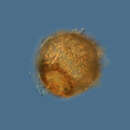Description of Difflugia
provided by BioPedia
Species with an agglutinated shell, with terminal, round, oval, lobed or teethed (but never slit-like) aperture, some with necklace but never with internal diaphragma. The pseudopodia are broad and with rounded ends (are lobose). Test always composed of mineral particles or diatoms in a structured or sheet-like organic cement. Many Difflugia select and arrange the building material according to size and shape to construct a species specific shell. The nucleus is mostly ovular in some species vesicular. Several freshwater species have green symbionts. The taxonomy of this genus is based mainly on differences in shape and size of their agglutinated shells. As the test is often opaque, cytoplasmic characters are rarely used. Small differences in shell size, shape or composition have been sufficient for many authors to describe more than 300 species and about 200 subspecies, varieties or forms with little regard to the value of the characters used, the previous literature, or the rules of nomenclature. Many of these descriptions are inadequate by modern standards and therefore the determination to species level is extremely difficult, even for the specialist; many species are common in freshwater sediments or between water plants others like D. hydrostatica are planktonic, D. lucida lives in dry mosses and soil. Feeding: mainly algae and fungi. Type species D. proteiformis Lamarck, 1816.

